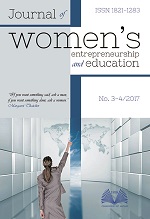A Generational Approach to Female Entrepreneurship in Europe
Main Article Content
Abstract
Female entrepreneurship is still a limited phenomenon in European countries and its promotion ranks high on the EU policy agenda. Various frameworks have been offered to explain the main structural differences in entrepreneurship between men and women, emphasizing a variety of underlying factors. With a novel approach, this paper argues that due to a process of generation renewal the numerical difference between male and female entrepreneurship will diminish. Generation replacement is seen by sociologists and other social scientists as the motor behind cultural renewal. Our core interest in this paper in developing such a dynamic interpretation within the European context is the role of different generations (Silent Generation, Babyboomers, Generation X, Millennials). Younger cohorts of females are hypothesized to be more pro entrepreneurship and pro self-employment both in terms of attitudes, intentions, and behaviors, compared to older cohorts. They are furthermore assumed to converge with their male generation members in this regard. This paper empirically tests these two hypotheses by analyzing multi cross-sectional European data from the Eurobarometer over a span of thirty-five years (1980-2015). Results show that this generational approach sheds new light on explaining trends in female entrepreneurship. We find evidence of an increased growth in female entrepreneurship that can be attributed to generation replacement. This rise in total female entrepreneurship is characterized by diversity among European countries in the study. Positive attitudes toward entrepreneurship are essential to considering future self-employment. Education is a key factor. Female entrepreneurship, it is predicted, will become more prominent in Europe.
Article Details
Section
Once the manuscript is accepted for publication, authors shall transfer the copyright to the publisher. If the submitted manuscript is not accepted for printing by the journal, the authors shall retain all their rights. The following rights on the manuscript are transferred to the publisher, including any supplementary materials and any parts, extracts or elements of the manuscript:
- the right to reproduce and distribute the manuscript in printed form, including print-on-demand;
- the right to print prepublications, reprints and special editions of the manuscript;
- the right to translate the manuscript into other languages;
- the right to reproduce the manuscript using photomechanical or similar means including, but not limited to photocopy, and the right to distribute these copies;
- the right to reproduce and distribute the manuscript electronically or optically using and all data carriers or storage media, and especially in machine readable/digitalized form on data carriers such as hard drive, CD-ROM, DVD, Blu-ray Disc (BD), Mini Disc, data tapes, and the right to reproduce and distribute the article via these data carriers;
- the right to store the manuscript in databases, including online databases, as well as the right to transmit the manuscript in all technical systems and modes;
- the right to make the manuscript available to the public or to closed user groups on individual demand, for use on monitors or other readers (including e-books), and in printable form for the user, either via the Internet, online service, or via internal or external networks.
Authors reserve the copyright to published articles and have the right to use the article in the same manner like third parties in accordance with the licence Attribution-Non-Commercial-Non-Derivate 4.0 International (CC BY NC ND). Thereby they must quote the basic bibliographic data of the source article published in the journal (authors, article title, journal title, volume, pagination).
